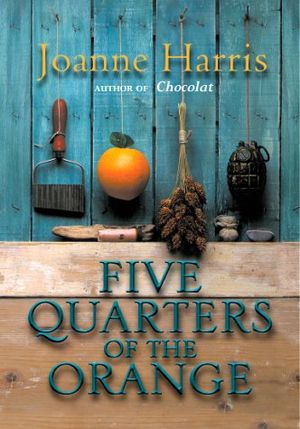Not to blow my own horn, but I totally nailed the first work book club meeting of the New Year. Work book club has been on a hiatus, and we decided in December to reconvene it, so I felt some pressure to make reconvened work book club awesome for everyone. I tried to go with a book everybody would both enjoy and have things to say about, and this book by Joanne Harris felt like a good choice. I know that she’s an enjoyable writer, because I liked Gentlemen and Players, and I also know that she can leave things ambiguous, which makes for good book club talks. I picked out this French place as a (themey) venue, which turned out to be a slam dunk because it had both couches and a happy hour, and it was not too crowded. YAY FOR JENNY.

Five Quarters of the Orange is about a woman called Framboise who has come back to the town where she grew up and opened up a cafe under an assumed name. She cannot use her own name because of some shit that went down in her childhood. We are not privy to what this was, but suffice it to say, her mother, now deceased, was mightily unbeloved of the villagers. And it had to do with Germans in World War II, when the town was occupied. The action of the story goes back and forth between the present day, when Framboise is trying to fend off her nephew and niece’s attempts to get her story out of her for profit, and her attempts to remember the past and figure out what her mother was thinking and doing.
Although I am a fan of double plotlines, it’s difficult for the two plotlines to achieve any kind of parity. Almost always, one plotline is notably awesomer than the other, and then you are always skimming through the less-interesting plotline, impatient to get back to the more-interesting plotline. Work book club universally seemed to agree with me on this. We all wanted the modern-day plotlines to knock it off and get us back to the flashbacks. Because what were these kids doing with the Germans? What information were they passing along and what were the consequences?
A more serious problem for me was the tonal difference between past and present. The plotline set during World War II is so dark. The kids are neglected, this one German soldier is nice to them, and they’re suckers for his kindness. The mother has these horrific migraines and becomes addicted to morphine, and it’s unclear what all she’s willing to do to get her supply of morphine. Whereas the present-day plotline has this almost Home-Alone-y feel, with Framboise and her friend Paul outwitting the nefarious, grasping villains who are trying to get her recipes and her story. It was jarring! I can understand the need for sections with a lighter tone, but in execution this didn’t work for me.
On the good side, Harris is good at ambiguity. The narrator is a secretive woman, and in keeping with that, she doesn’t tell everything. We never find out exactly what happened with her older sister, Reinette, although we can draw conclusions from what we are told. The broader story of the village is the same way — we can deduce roughly what other people were up to, but it’s all deduction. Framboise doesn’t spell it out for us.
Goodish, I would say? A very good book club book and an acceptably good book for me? I didn’t like it as much as Gentlemen and Players, and I didn’t dislike it the way I did Chocolat. I think Joanne Harris may be one of those middle-of-the-road authors to me, where I get her books from the library occasionally but never ever buy one.